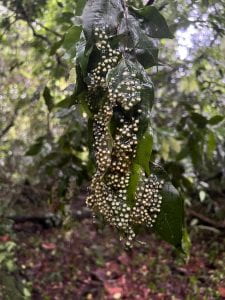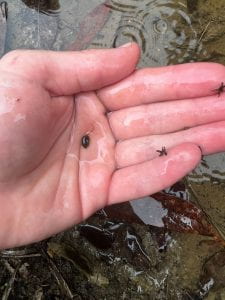Today marked our transition from aquatic tropical field biologists to terrestrial TFBs. We started the process of testing a research question that we could answer using camera traps. These “camera traps” are discrete cameras attached to trees throughout the forest, and snap a photo when an animal moves past the sensor. We decided to test how the distribution of predator and prey of various sizes would differ based on the camera’s placement on either trails, roads, or in the thick of the forest. We thought large predators would take advantage of the ease of travel on trails and roads (as safety is not as big of a concern for animals of their stature), yet we expected smaller prey and predators to be more often sighted (relative to their own groups) in the thick of the forest, because of the protection of the trees. We will collect these cameras on the last day, and hopefully have some interesting a fun data to look through.
Setting up the cameras was a bit of a big endeavor though. Navigating the forest terrain was definitely difficult and a new learning curve. We traveled fairly slowly, as we were all fascinated by the documentary-quality views of the trees/plants, and as we all hunted to find something relating to our taxonomic group. I didn’t have much hope of finding anything related to amphibians, but boy was I wrong. Thankfully we are here during the wet season, which gives us the best chance of encountering water-loving amphibians (which tend to be most active this part of the year). We first came across several tire tracks in the mud, which collected puddles of water, and in the water were hundreds of small tadpoles! Identifying species from tadpoles is quite difficult, as there are many more similarities and less distinctive colors, yet it was a fun find. There were clearly at least two distinct species though. In one puddle the tadpoles were small and nearly black with no obvious pattern, yet the other puddle had tadpoles that were larger (so probably older) and had a distinct pattern of off-white and dark grey blotches.
When we went to set up our last camera at the appropriately named “Frog Pond.” I was at first sad to see no standing water in the area, but to my surprise, there were huge clumps of treefrog eggs hanging from the leave at face height. These clumps of clear jelly contained probably a few hundred treefrog embryos. An amazing sight to see. Dr. Solomon was telling us how the frog eggs have adapted the ability to sense vibrations from a predatory snake slithering on the branches and prematurely hatch to avoid being eaten. The complexity and creativity of nature is truly unmatched. I am excited for tomorrow and hope to see more amphibians but I know they’re not too common to encounter so we will have to see.


